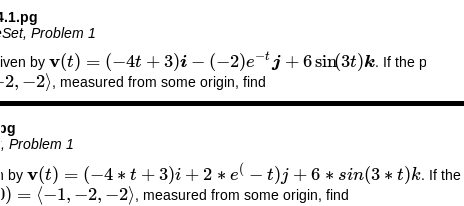Another WeBWorK installation updating question. I have a problem that defines a vector valued function with a series of Computes and then displays it to the user, a la the following.
$v1 = Compute("($twoc1)*t+$c2");
$v2 = Compute("-$c1*e^(-t)") );
$v3 = Compute("-($c1c2)*sin($c2*t)");
$vel = Vector( $v1, $v2, $v3 );
Context()->texStrings;
BEGIN_TEXT
The velocity of a particle is given by
\( {\bf v}(t) = \{ $vel->ijk \} \)
...
When I'm running PG on branch release/2.6 it displays as I expect, as in the top figure in the attached (below). When I'm running PG on branch master (updated today) I get the display in the bottom. In both cases I'm running WeBWorK on master, updated today.
Is this a feature change, a bug, or a subtle (or, as many of them, not so subtle) error on my part?
Thanks,
Gavin
